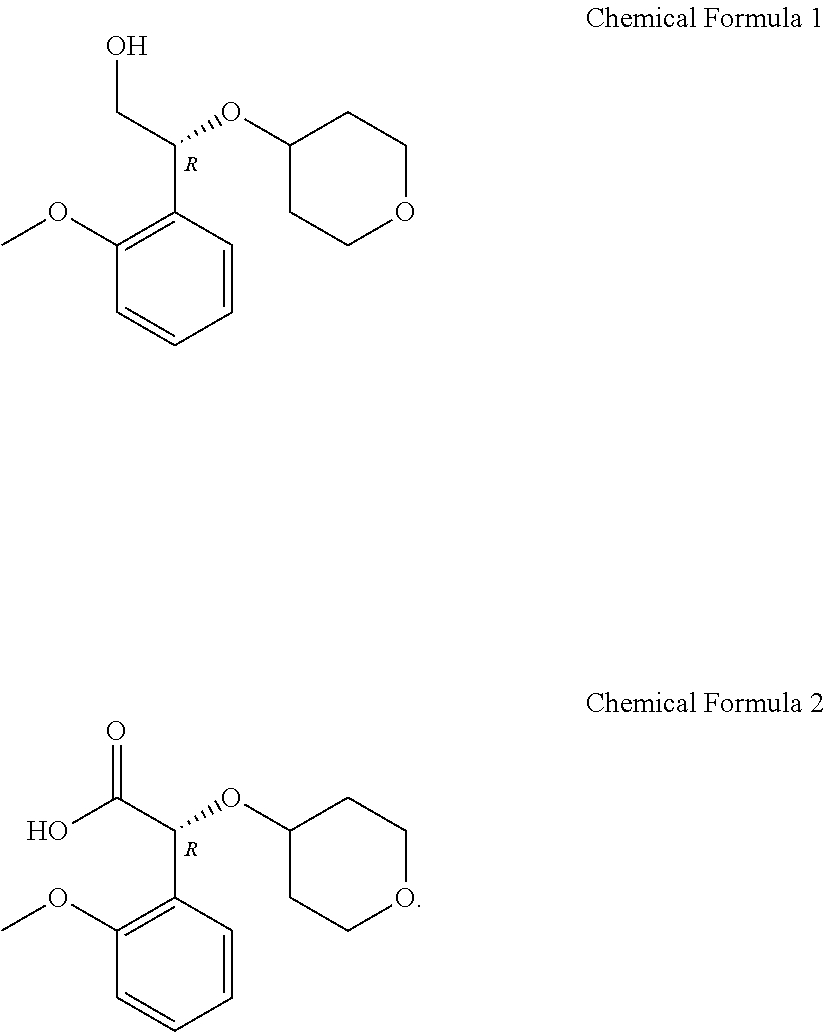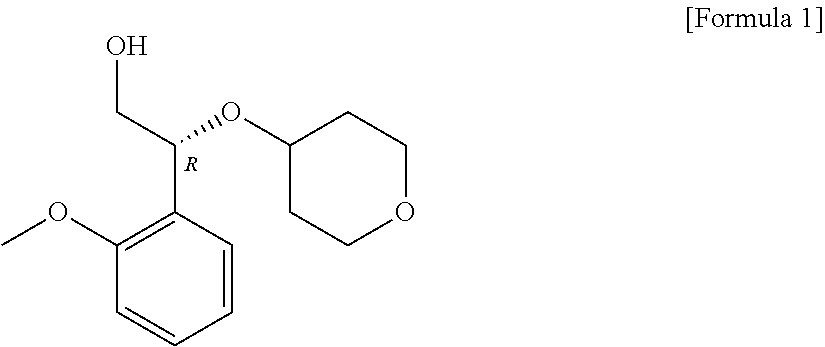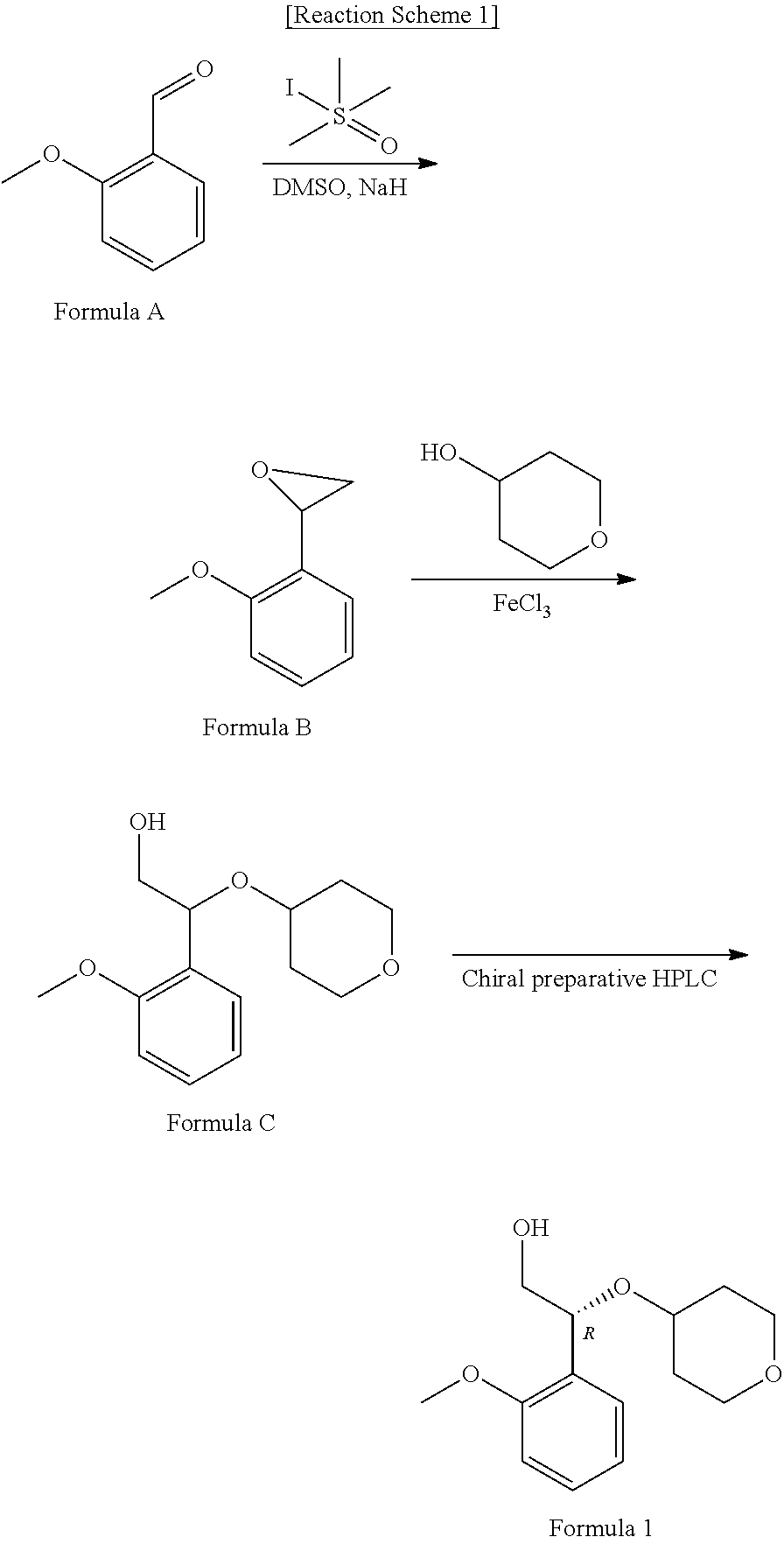Novel method for preparing (2R)-2-(2-methoxyphenyl)-2-(oxane-4-yloxy)ethane-1-ol compound, and intermediate used therein
a technology of oxane-4-yloxy and ethane, which is applied in the field of compounds, can solve the problems of unsuitable industrial mass production methods, generated impurities must be purified using column chromatography, etc., and achieves the effect of simple and efficient manner
- Summary
- Abstract
- Description
- Claims
- Application Information
AI Technical Summary
Benefits of technology
Problems solved by technology
Method used
Image
Examples
example 2
on of 2-(2-methoxyphenyl)-2-((tetrahydro-2H-pyran-4-yl)oxy)acetic acid (Formula 4)
[0089]
[0090]80 g (0.271 mol) of ethyl 2-(2-methoxyphenyl)-2-((tetrahydro-2H-pyran-4-yl)oxy)acetate of Formula 5 prepared in Example 1 was dissolved in 640 ml of ethanol, and an aqueous solution of 22.8 g (0.543 mol) of lithium hydroxide dissolved in 160 ml of water was added thereto, followed by stirring at room temperature for 2 hours. After the reaction was completed, 800 ml of water and 1,200 ml of ethyl acetate were added sequentially and separated to remove the organic layer. The aqueous layer was washed once more with 400 ml of ethyl acetate and the pH of the aqueous layer was adjusted to pH 1 to 2 using hydrochloric acid and extracted twice with 800 ml and 400 ml of dichloromethane. The product was dried over anhydrous magnesium sulfate and distilled under reduced pressure to obtain 70 g (yield 97%) of the titled compound (Formula 4) as a foam phase.
[0091]1H-NMR (300 MHz, CDCl3): 7.40-7.31 (m, 2...
example 3
on of Salt (Formula 3) from 2-(2-methoxyphenyl)-2-((tetrahydro-2H-pyran-4-yl)oxy)acetic acid (Formula 4) and (1R,2S)-2-amino-1,2-diphenylethanol (Formula 8)
[0092]
[0093]After dissolving 70 g (0.262 mol) of 2-(2-methoxyphenyl)-2-((tetrahydro-2H-pyran-4-yl)oxy)acetic acid of Formula 4 prepared in Example 2 in 490 ml of ethyl acetate, 56 g (0.262 mol) of (1R,2S)-2-amino-1,2-diphenylethanol of Formula 8 was added thereto, followed by stirring at room temperature for 20 hours. The resulting solid compound was filtered, washed with 70 ml of ethyl acetate and dried to obtain 71 g (yield 56%, HPLC optical purity 65.2%) of the crude product of the titled compound (Formula 3) as a solid phase.
[0094]70 g (0.146 mol) of the crude product of the titled compound (Formula 3) was added to 490 ml of ethyl acetate containing water and heated to reflux at 60° C. to 70° C. for 30 minutes. The reaction solution was cooled to room temperature and stirred for 16 hours. The resulting solid was filtered, was...
example 4
on of (R)-2-(2-methoxyphenyl)-2-((tetrahydro-2H-pyran-4-yl)oxy)acetic acid (Formula 2)
[0097]
[0098]19 g (0.040 mol) of the compound of Formula 3 prepared in Example 3 were added to 190 ml of dichloromethane and 190 ml of water, the pH was adjusted to 1 to 2 using 1N aqueous hydrochloric acid solution, the organic layer was taken, and the aqueous layer was extracted once more using 190 ml of dichloromethane. The organic layer was dried over anhydrous magnesium sulfate and distilled under reduced pressure to obtain 8.8 g (84%) of the titled compound (Formula 3).
[0099]Melting point: 120° C.-125° C.
[0100]GC / MS spectrum: m / z=265.02 (M-1)
[0101]The pH of the aqueous layer was adjusted to pH 7 to pH 8 using aqueous sodium hydroxide solution, and the resulting solid was filtered, washed with water and dried to obtain 7.5 g (94%) of (1R,2S)-2-amino-1,2-diphenylethanol (Formula 8).
PUM
| Property | Measurement | Unit |
|---|---|---|
| Temperature | aaaaa | aaaaa |
Abstract
Description
Claims
Application Information
 Login to View More
Login to View More - R&D
- Intellectual Property
- Life Sciences
- Materials
- Tech Scout
- Unparalleled Data Quality
- Higher Quality Content
- 60% Fewer Hallucinations
Browse by: Latest US Patents, China's latest patents, Technical Efficacy Thesaurus, Application Domain, Technology Topic, Popular Technical Reports.
© 2025 PatSnap. All rights reserved.Legal|Privacy policy|Modern Slavery Act Transparency Statement|Sitemap|About US| Contact US: help@patsnap.com



